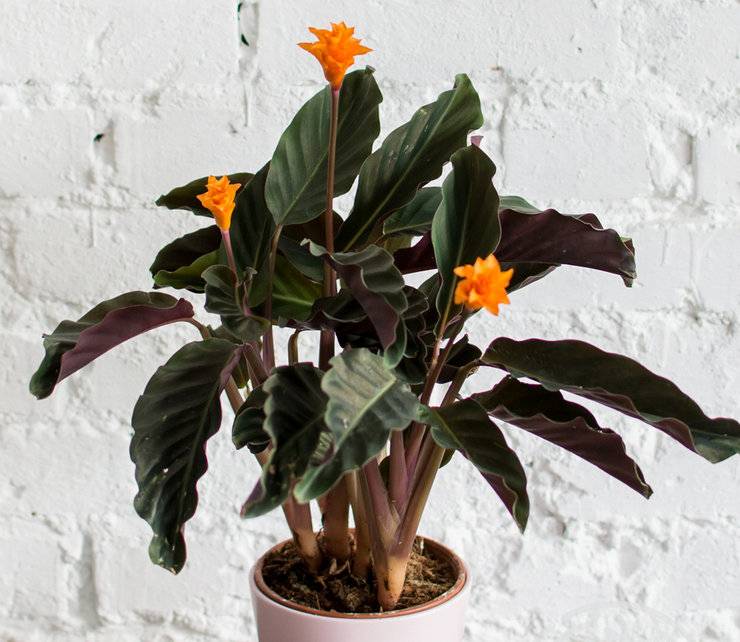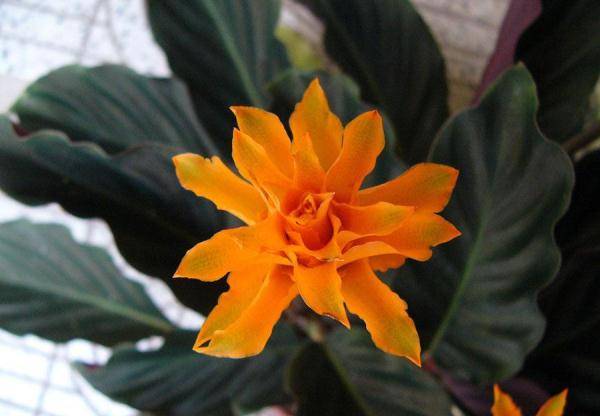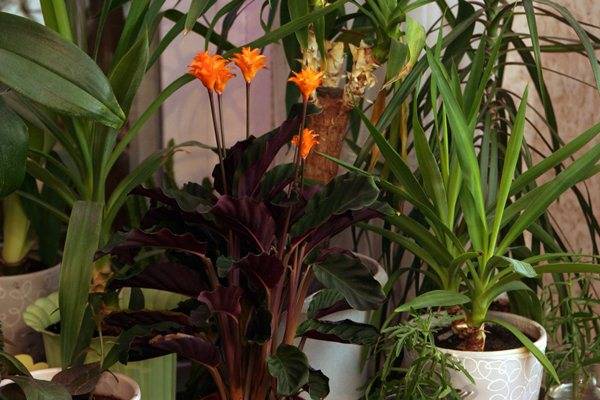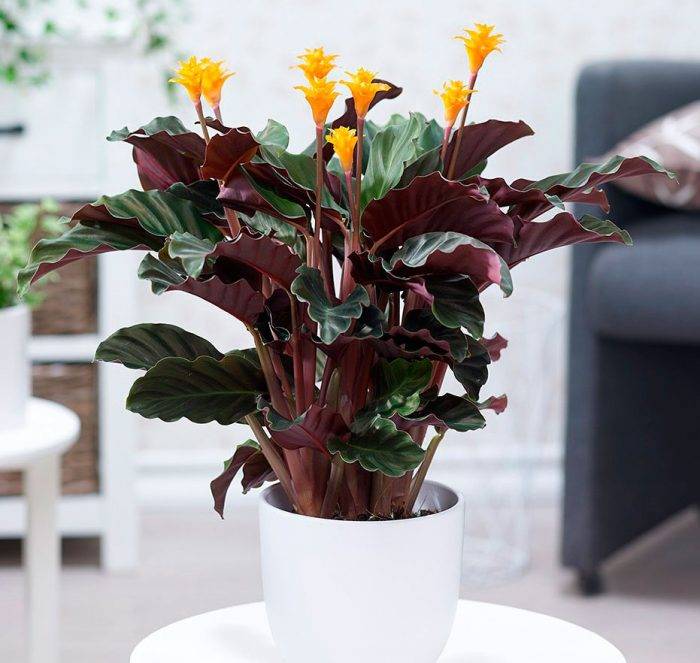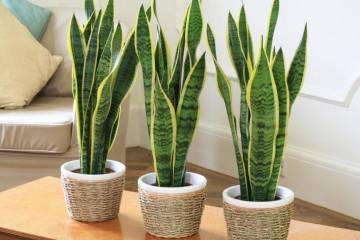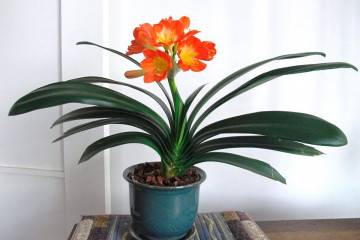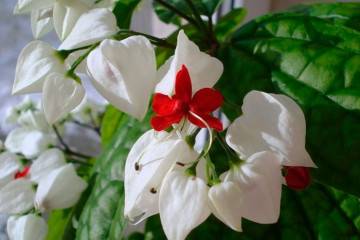Calathea Crocata - home care
Content:
From the motley and bright variety of different types of kalata, Crokat, or Saffron kalatea, stands out not so much with decorative multi-colored leaves, as with colorful flowering, which occurs in the winter months. But in return, the capricious beauty requires attention and proper care.
Appearance of Calathea Crokat
Calathea Crokata is a compact perennial plant (about 40 cm in height). Large and smooth leaves have a slight waviness around the edge. They are painted in a rich green color, and the underside is purple. There is a characteristic pattern on the surface of the foliage, but it is not as pronounced and bizarre as in other plant subspecies.
Calathea Saffron blooms with bright yellow-orange flowers.
Since the plant is native to the tropics, calathea cannot stand air temperatures below 18-20 degrees Celsius. That is why the plant is cultivated exclusively as an indoor plant. It is often grown in greenhouses, where it is easier to achieve conditions close to natural for the plant.
Calathea Saffron - home care
Calathea Saffronnaya requires compliance with the conditions of detention. Only in this way can the flower please with lush foliage and long flowering.
Temperature
The heat-loving beauty Calathea crocata will feel normal at temperatures around 23-25 degrees Celsius. In winter, it is allowed to lower the temperature to 16-18 degrees Celsius, but at the same time it is necessary to reduce watering, thus providing the plant with a rest period. But this is not relevant for the Crocata blooming in the winter months.
Lighting
For Calathea Crokat, or rather, when caring for her at home, the correct location is very important. The flower needs enough sunlight, but not in places open to the sun, where the leaves can burn.
In order for the calathea to bloom in the winter, it needs light for 8-10 hours a day. Therefore, additional sources of illumination are organized for the plant.
Watering
For watering calathea, it is best to use soft and warm water, which is defended before that for at least two days. The procedure is carried out every 2-3 days in the summer, and a little less often in the winter - about once a week.
Irrigation
Since Calathea Crokata is a tropical inhabitant, it needs regular irrigation, which is carried out 1-2 times a week with warm soft water. Also, this type of calathea can be regularly bathed under a warm shower, but it is imperative to cover the soil.
Humidity
To create the necessary air humidity, pebbles or expanded clay are placed in the pan of the flowerpot and maintain constant moisture there. They also practice spraying moisture near the flower, thus increasing the humidity of the air.
Priming
The main criteria when preparing a substrate for planting calathea: air and water permeability. It must be well drained. If the soil mixture is prepared independently, then you need to mix leafy soil, sand, peat and add crushed bark, ash, coniferous soil.
Top dressing
Calathea needs nutrients during the active growing season. To do this, use complex fertilizers in liquid form 2 times a month. In winter, it will be enough to do it once every 1-1.5 months.
Home care in winter for Calathea Crocata
In order for the calathea to have enough strength to bloom for a long time, she needs to prepare. Therefore, starting from October until the moment the buds appear, the plant should have no more than 10 hours of daylight hours. For this, from 6 pm to 8 am, the flower is covered with a black bag. But at the same time, it is imperative to control so that he does not touch the leaves.
Tap water can be softened by leaving peat in it overnight. A handful of peat will be enough for a bucket of water, which is immersed wrapped in cheesecloth.
Flowering features
For the successful flowering of calathea in winter, it needs light for 8-10 hours a day. Therefore, if necessary, the plant is provided with additional sources of illumination.
Breeding methods for Calathea Crokat
Сalathea Crocata can be propagated in the following ways:
- Germination of seeds. This method is quite lengthy. The seeds sown without deepening are irrigated and placed either in a greenhouse, or the crops are covered with glass or polyethylene. The seed containers are placed in a well-lit area and the soil is kept moist. When independent plants are formed, they are seated in separate containers.
- Rooting cuttings. In this method, the healthy side sheets are carefully cut with a sharp knife and rooted in a moist substrate. In order for the shoot to take root better, before planting, you can place its lower part in a growth stimulant solution.
- By dividing the rhizome. This is the simplest way of reproduction of calathea, in which, during transplantation, the old plant is divided into several parts and planted in different flowerpots.
Transfer
It is recommended to transplant young plants annually. After reaching 4-5 years of age, this can be done every 2-3 years. The optimal time for the procedure is early spring, before the active growth of the flower begins.
Possible problems and diseases of the plant
Violation of the basic rules for caring for calathea leads to various problems, and also contributes to the development of diseases and pest damage. Common difficulties in growing calathea:
- sheds buds and leaves - the plant has suffered from drafts or temperature changes;
- leaves turn pale - this indicates a lack of lighting;
- the tips of the leaves dry - insufficient watering and moisture;
- lower leaves fall off - excess or lack of moisture.
Pests
Among the main pests that often bother Kalatea, first of all, spider mites should be called. It settles on the underside of the leaf plate, and the presence of cobwebs indicates its presence. Its appearance indicates too dry indoor air.
Treating the leaves with soapy water helps to get rid of the pest. If the lesion is significant, then insecticide treatment is used.
Signs and superstitions
The presence of calathea in the house brings indisputable benefits: the plant cleans the air of harmful impurities, tobacco smoke, kitchen odors and other unpleasant odors in the house thanks to its large leathery leaves.
In addition, calathea is endowed with magical properties. It is believed that this flower promotes harmony and love in the home. The plant is able to absorb negative energy in the house, bringing calm and peace to it.
Calathea Crokata (Saffron) is a colorful ornamental plant with large leathery leaves with a characteristic pattern and bright yellow-orange flowers. Calathea Saffronnaya requires care and high humidity, does not tolerate temperature extremes and drafts. But the presence of this flower in the house contributes to the reign of love, harmony and fun in it.

